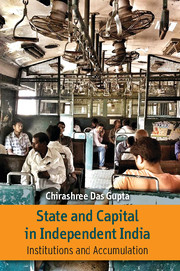Book contents
- Frontmatter
- Dedication
- Contents
- Figures
- Tables
- Acknowledgements
- 1 Introduction
- 2 Globalization and Neoliberalism: The Context and the Debate
- 3 State and Capital in Independent India: The Problematic
- 4 Policy Regimes and Macroeconomic Outcomes: 1947–1966
- 5 Institutionalization of the Regime of Capital in India: 1947–1966
- 6 Continuity and Change in Capital Accumulation: 1966–1980
- 7 Sources of Accumulation: State Intervention and Non-intervention
- 8 ‘Old Oligopolies and New Entrants’ in the Pharmaceutical Sector
- 9 Conclusion
- Bibliography
- Index
1 - Introduction
Published online by Cambridge University Press: 05 September 2016
- Frontmatter
- Dedication
- Contents
- Figures
- Tables
- Acknowledgements
- 1 Introduction
- 2 Globalization and Neoliberalism: The Context and the Debate
- 3 State and Capital in Independent India: The Problematic
- 4 Policy Regimes and Macroeconomic Outcomes: 1947–1966
- 5 Institutionalization of the Regime of Capital in India: 1947–1966
- 6 Continuity and Change in Capital Accumulation: 1966–1980
- 7 Sources of Accumulation: State Intervention and Non-intervention
- 8 ‘Old Oligopolies and New Entrants’ in the Pharmaceutical Sector
- 9 Conclusion
- Bibliography
- Index
Summary
These masses of people you are seeing
Have heard Him guaranteeing
A great time by and by.
Meanwhile they must make sacrifices
As the shops all put up their prices
That great time is pie in the sky.
(Adapted from Bertolt Brecht: Fear and Misery of the Third Reich)Post-independence political economy in India has been characterized by Ghosh (1998) as a drama enacted between votaries and opponents of liberalization. At one level, it is posited as a drama based on academic debates stemming from different ideological positions and different perspectives on the Indian economy (Ghosh, 1998). Byres (1997, 1998) and Ghosh (1998) provide excellent historicized reviews of these debates on planning and state policy respectively within the academic literature in India. The other level was of actual state action, which had less correspondence with this debate and was determined by the relative power of political configurations within society (Ghosh, 1998). This is the area that has received relatively less attention, though each of the ‘liberalization’ episodes in the history of independent India saw a concomitant academic debate. The two levels of debate according to Ghosh (1998) have merged occasionally in history but since the 1980s, there was a decisive merger of the two. This was a part of the political process of the shift of the state from dirigisme to neoliberalism as opposed to a specific deregulation or liberalization that is a feature of the entire post-independence period.
The origins of these debates can be traced to the ideological struggle within the national liberation movement before independence. The arguments and ideological debates about the role of the state in the building and expansion of a viable capitalism in India were evident in the actual arena of state–society relations and political action, which defined the contours and limits of the relationship between state and capital in the decade preceding independence.
- Type
- Chapter
- Information
- State and Capital in Independent IndiaInstitutions and Accumulations, pp. 1 - 8Publisher: Cambridge University PressPrint publication year: 2016



